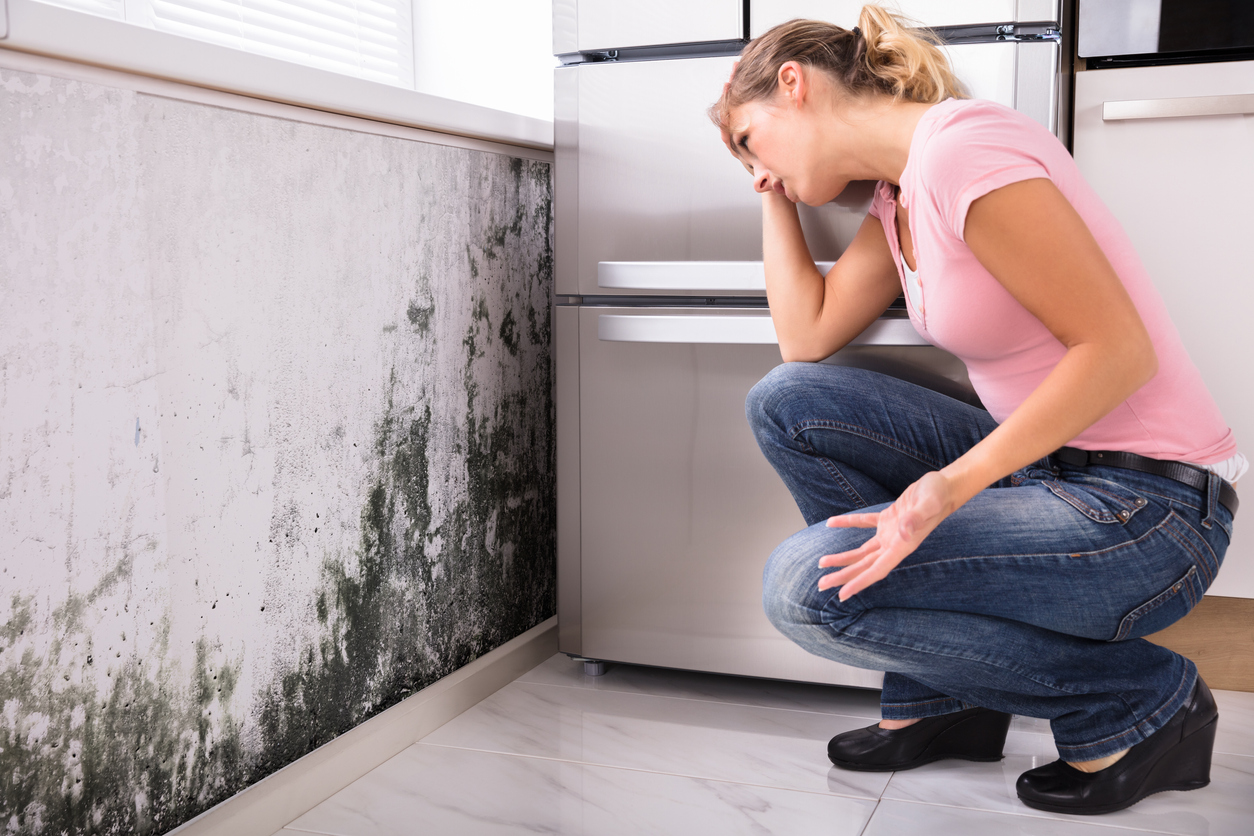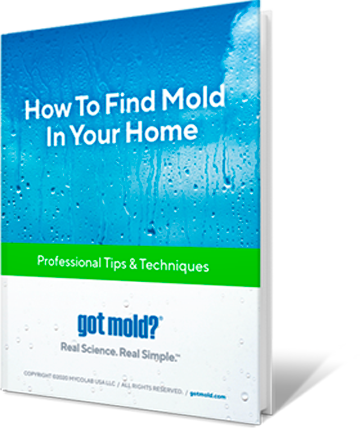
Are you monitoring humidity levels in your home? Maintaining an ideal humidity range inside your home is more important than you may think. The amount of moisture in the air (humidity) in your home can mean the difference between a healthy home or one that’s making you sick.
Even without a humidity gauge (known as a hygrometer) to measure the amount of moisture in your air, determining if you have a humidity problem is fairly simple—assuming you know what to look for.
5 Symptoms of High Humidity in Your Home
These five issues can be directly tied back to excess humidity or a water leak in your home.
Mold
A mold problem in your home always originates from a moisture problem.
Anywhere from 30% to 50% of homes globally have issues with dampness and mold, according to a World Health Organization (WHO) Report on Indoor Air Quality – Dampness and Mold.
Mold spores, which are like microscopic reproductive seeds, are found in the dust and surfaces of every house, including those that don’t have issues with dampness, says WHO.
Mold spores are ubiquitous.
Spores make their way into your home through open windows and doors or by hitching a ride on shoes, clothing, and even pets. And then they wait for the right conditions to thrive.
“Once fungi are indoors,” says the WHO report, “growth can occur only in the presence of moisture.”
Like all living things, mold also needs nutrients to survive. And your house offers plenty of those in the form of common dust, construction materials, wallpaper, wood, paint, glue, books, and other paper products (to name a few). Modern buildings are made of materials that most molds find delicious, such as drywall, so there’s no shortage of nutrition.
Since removing all fungi food sources from your home is nearly impossible, maintaining ideal humidity levels is critical for preventing mold growth.
Insects, Pests, and Arachnids
Spiders, dust mites, and rats, oh my! The second sign of excess moisture and humidity in your home is an increase in uninvited critters and creepy crawlies.
Critters need moisture to survive, and damp homes offer plenty of water for insects, arachnids, and rodents to drink up.
Not to mention the miniature “circle of life” that occurs once mold becomes a food source for small bugs, which then become a food source for larger bugs and spiders, which, in turn, become a food source for rodents, and so on.
Dust mites in particular love to eat mold! (Researchers have found mold spores in their feces and attribute much of the allergenicity to the unique qualities of this lovely combination.)
They’re not the only critters that like to make mold a meal, either.
Booklice (small, soft-bodied insects) usually eat mold, fungi, and glue from book bindings. In homes, booklice are often found in damp areas and are a clear signal that your home has a mold problem.
And then the spiders come along and eat the booklice. And the rodents eat the spiders. It’s like the nursery rhyme, There Was an Old Lady Who Swallowed a Fly.
The longer the moisture problem, the larger the critters and the more of them you’ll find. Take away the water and they’ll go somewhere else to party. It’s that simple.
Respiratory Health Issues
Could respiratory health issues have more to do with poor indoor air quality, due to dampness and mold in your home, than viruses or bacteria? Emerging medical research supports this notion.
A pair of studies from the U.S. Department of Energy’s Lawrence Berkeley National Laboratory (Berkeley Lab) and the U.S. Environmental Protection Agency (EPA) estimates that 21 percent of current asthma cases in the U.S. are attributable to dampness and mold exposure.
In other words, of the 21.8 million people reported to have asthma in the U.S., approximately 4.6 million can be traced back to dampness and mold exposure, according to study researchers.
And, when it comes to predicting who will develop asthma, growing up in a damp and moldy home is second only to family history as a risk factor.
Did you know? Kids who live in a house with a musty “moldy” odor are twice as likely to get asthma than kids who don’t.
So how does dampness contribute to asthma?
Researchers suggest that it’s not the excess moisture itself that causes asthma issues. Rather, the moisture influences the growth of various microorganisms which can then lead to respiratory health issues.
In another study on indoor dampness and asthma, researchers suggest that dampness may lead to the development of asthma and exacerbate existing asthma issues. They concluded that the factors related to dampness causing asthma were most likely fungi and dust mite allergens.
Furthermore, recent epidemiologic studies and meta-analyses show indoor dampness or mold to be consistently associated with increased asthma development and exacerbation, dyspnea, wheeze, cough, respiratory infections, bronchitis, allergic rhinitis, eczema, and upper respiratory tract symptoms—in both allergic and nonallergic individuals.
Rot and Decay
A building’s longevity is directly connected to its ability to shed water.
In a Building Moisture and Durability report prepared for the U.S. Department of Housing and Urban Development (HUD), moisture is named the “single greatest threat to the durability and long-term performance” of homes and buildings.
Excessive exposure to moisture is not only a common cause of significant damage to many types of building components and materials, states the report, but it also can lead to unhealthy indoor living environments.
Some of the more serious effects resulting from moisture problems in houses include:
- decay of wood and corrosion of metals
- infestation by termites, carpenter ants, and other insects
- negative impacts on indoor air quality
- the growth of mold, mildew, and other biological contaminants
- reduced strength in building materials
- expansion/contraction damage to materials
- reduced thermal resistance of wet insulation
- premature failures of paints and coatings
- damage to building contents
- negative effects on building aesthetics
Why is moisture public enemy #1 when it comes to the durability of your home?
Consider the materials used to build a single-family or multi-family residence.
Most building structures begin with a concrete slab foundation that sits in the surrounding soil. Concrete is made from a mixture of crushed stone and a paste made from water and cement. During the drying and curing process, most of the water from inside the concrete works its way out through tiny highways called capillaries. Unfortunately, these tiny moisture highways are two-way streets: Not only can water work its way out of the concrete, but water can also work its way back in via excess humidity, water leaks, and even excess moisture in the soil around the house. (This is known as capillary action.)
It’s like a giant sponge sitting at the base of your home.
Now consider typical building materials that go on top of that concrete slab foundation, such as wood, gypsum wallboard, fluffy insulating materials, carpet, and carpet padding, to name a few. Like concrete, these materials also act like sponges when it comes to moisture, but, unlike concrete, they do double-duty as nutrient sources for fungi.
This is why we recommend you don’t finish your basement…until you read this.
Fungi cause considerable damage to buildings, according to the WHO Guidelines for Indoor Air Quality.
Structural Issues
Not even the dimmest of the three little pigs ventured to make a home out of paper, yet with drywall at the center of our modern construction process, it is much like building houses out of paper maché.
We essentially build ourselves self-composting homes; just add water. The wood we build with is often young and loaded with sap—a tasty treat to wood-eating bugs such as termites, wood-rotting fungi, and others.
And, as we covered above, our building materials are prone to rapid degradation when exposed to moisture.
Too much dampness in a building can erode away building materials—corroding metals, decaying timber, softening and crumbling plaster, and disintegrating bricks, stones, tiles, and flooring.
As damp building materials degrade, they release emissions of volatile organic compounds (VOCs)—including formaldehyde—which can lead to increased indoor air pollution and negative health effects for occupants. The use of potentially hazardous chemicals such as pesticides to target termites and pests, or chemical biocides meant to “kill” mold, can add even more VOCs to the indoor air, often leaving a toxic residue on surfaces, which can become easily airborne and inhaled.
Nasty stuff.
Worse yet, structural damage from a moisture problem at home most likely isn’t covered by your insurance policy. Most homeowners’ policies are designed to cover structural damage that occurs as a result of a specific event (like a hurricane or explosion), NOT from chronic dampness in your home. Damage that happens gradually—like the settling, shrinking, and cracking of your foundation—is typically excluded by homeowners insurance.
This means you could be left holding the bag for your structural damage caused by dampness, mold, and termites.
Now What?
Now that you know that mold, pests, respiratory illnesses, rot, decay, and structural issues are all signs that you have a moisture problem at home, what comes next? Check out our Complete Guide to Moisture and Humidity in the Home to discover what your ideal household humidity level should be and what steps to take to address the moisture problems harming your home.

